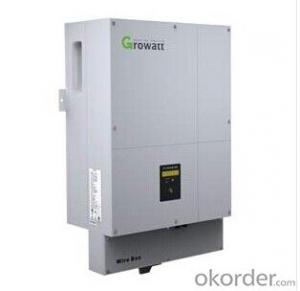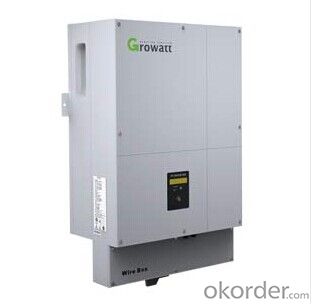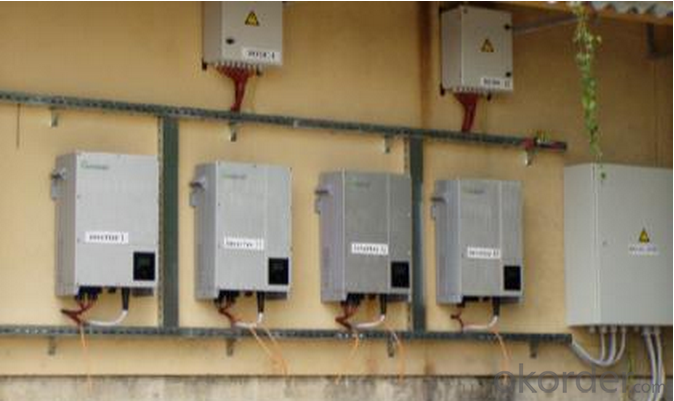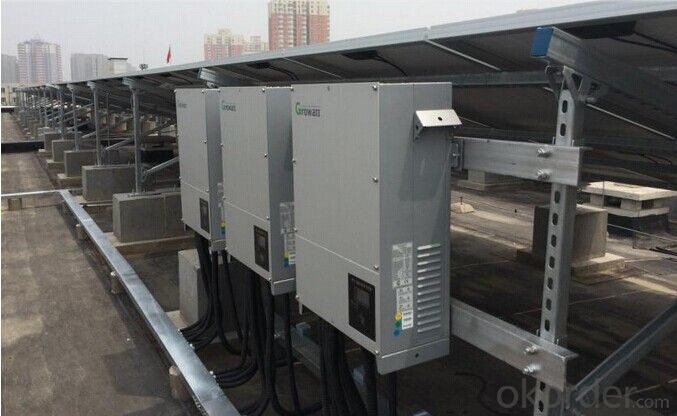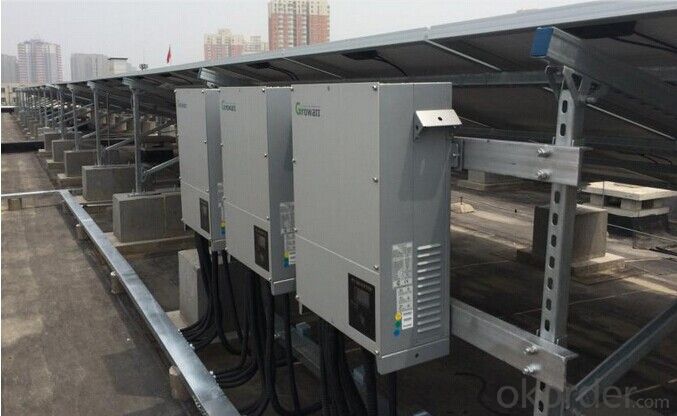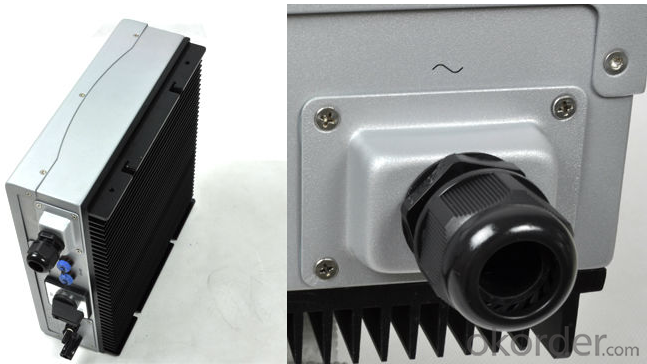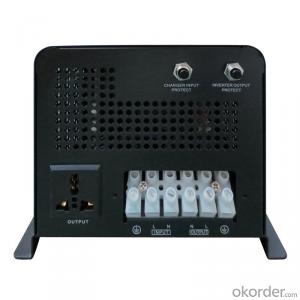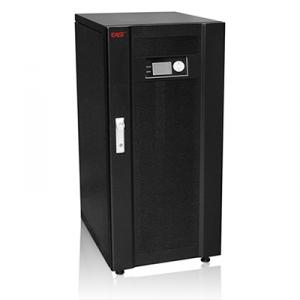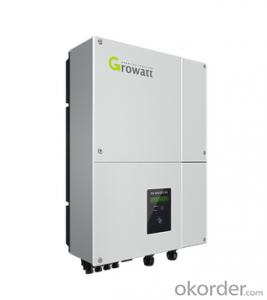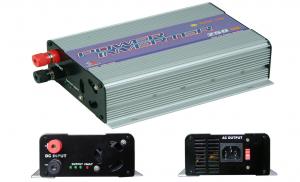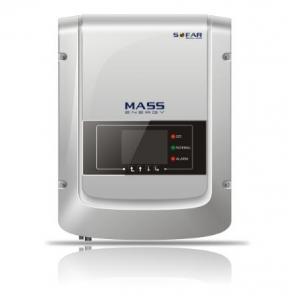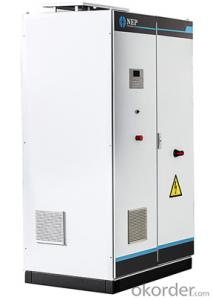Solar Inverter Company Grid Tied Solar Inverter 8000W-11000W Max 8300W TUV/UL/CSA/FCC
- Loading Port:
- Shekou
- Payment Terms:
- TT or LC
- Min Order Qty:
- 10 pc
- Supply Capability:
- 100000 pc/month
OKorder Service Pledge
OKorder Financial Service
You Might Also Like
Grid Tied Solar inverter 8000-11000kw
High efficiency of 97.8% delivery more energy
Integrated DC disconnect switch
Consistent and stable performance across entire input voltage and output power voltage
Intelligent temperature management
Power balancer for three-phase grid connection
Bluetooth/ RF technology/ Wi-Fi
Sound control, easy installation maintenance procedure
Newest generation IGBTs and advanced MPPT algorithms
8000TL-US | 9000TL-US | 10000TL-US | 11000TL-US | |
| Inputdata | ||||
| Max. DC power | 8300W | 9300W | 10350W | 11400W |
| Max. DC voltage | 600V | 600V | 600V | 600V |
| Start Voltage | 360V | 360V | 360V | 360V |
| DC nominal voltage | 345V@ 208VAC 379V@ 240VAC | 345V@ 208VAC 379V@ 240VAC | 345V@ 208VAC 379V@ 240VAC | 379V |
| PV voltage range | 300-600V@208V 345-600V@240V | 300-600V@208V 345-600V@240V | 300-600V@208V 345-600V@240V | 345-600V@208V 345-600V@240V |
| MPP voltage range(full load) | 300-480V@208V 345-480V@240V | 300-480V@208V 345-480V@240V | 300-480V@208V 345-480V@240V | 300-480V@208V 345-480V@240V |
| Max. input current/per string | 30A/16A | 33A/16A | 36A/16A | 35A/16A |
| Number of MPP trackers/ strings per MPP tracker | 1/4 | 1/4 | 1/4 | 1/4 |
| Efficiency | ||||
Max.efficiency | 97.8% | 97.8% | 97.8% | 97.5% |
| Rated AC output power | 8000W | 9000W | 10000W | 11000W |
| AC nominal voltage; range | 208V/240V;183-229V@208V,211-264V@240V | |||
| Max. output current | 44A@208V 38A@240V | 44A@208V 38A@240V | 44A@208V 38A@240V | 38A@240V |
| AC grid frequency; range | 60Hz; 59.3-60.5Hz | 60Hz; 59.3-60.5Hz | 60Hz; 59.3-60.5Hz | 60Hz; 59.3-60.5Hz |
| Power factor | 1 | 1 | 1 | 1 |
| THDI | <3% | <3% | <3% | <3% |
| Grid connection type | Two phase | Two phase | Two phase | Two phase |
| Features | ||||
Display Warranty: 10years/15years | LCD opt/opt/opt | LCD opt/opt/opt yes/opt | LCD yes/yes/ opt/opt/opt yes/opt | LCD opt/opt/opt yes/opt |
| Generaldata | ||||
Dimensions(W/H/D) in mm Weight Operating temperature range Noise emission(typical) Self-Consumption (night) Topology Cooling concept Environmental Protection rating Altitude Relative Humidity | 400/743/222 40KG -25℃ ... +60℃ <46db(a)< p=""> <0.5W Transformerless Smart cooling NEMA 3R 2000m withoutderating 0~100% | 400/743/222 40KG -25℃ ... +60℃ <46db(a)< p=""> <0.5W Transformerless Smart cooling NEMA 3R 2000m withoutderating 0~100% | 400/743/222 40KG -25℃ ... +60℃ <46db(a)< p=""> <0.5W Transformerless Smart cooling NEMA 3R 2000m withoutderating 0~100% | 400/743/222 40KG -25℃ ... +60℃ <46db(a)< p=""> <0.5W Transformerless Smart cooling NEMA 3R 2000m withoutderating 0~100% |
| Certificates and ApprovalsUL 1741, UL 1998, IEEE 1547, FCC part 15(Class B), CSA C22.2 No. 107.1 |
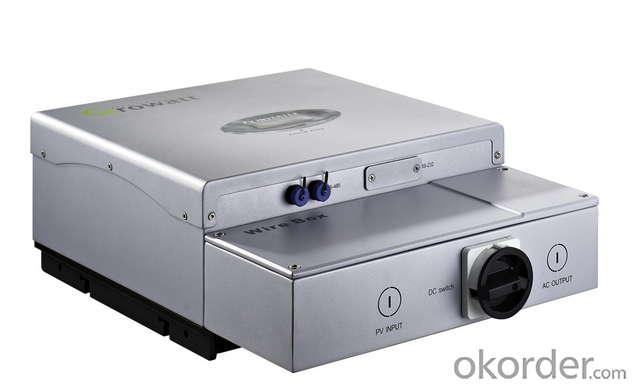
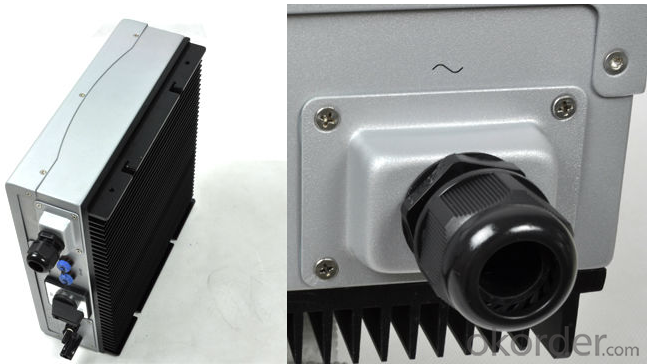
- Q: Can a solar inverter be used with a solar-powered air cooling system?
- Yes, a solar inverter can be used with a solar-powered air cooling system. The solar inverter is responsible for converting the direct current (DC) generated by the solar panels into alternating current (AC) that can be used to power various devices, including air cooling systems. By connecting the solar panels to the solar inverter, the generated solar energy can be efficiently utilized to power the air cooling system, making it a sustainable and eco-friendly cooling solution.
- Q: What are the indicators of a faulty solar inverter?
- Some indicators of a faulty solar inverter include, but are not limited to, a sudden drop in power output, unusual noises or vibrations coming from the inverter, error messages or warning lights displayed on the inverter's screen, frequent shutdowns or restarts, and a lack of communication or connection with the solar monitoring system.
- Q: What is the role of a display or user interface in a solar inverter?
- The role of a display or user interface in a solar inverter is to provide real-time information and control capabilities to the user. It allows the user to monitor the performance of the solar inverter, such as the amount of power being generated, the voltage and current levels, and any error or warning messages. The display also enables the user to adjust various settings and parameters of the inverter, such as the operating mode, output voltage, or charging profiles. In essence, the display or user interface acts as a communication tool between the user and the solar inverter, facilitating efficient operation, monitoring, and troubleshooting.
- Q: How does a solar inverter convert DC to AC?
- A solar inverter converts direct current (DC) electricity generated by solar panels into alternating current (AC) electricity that can be used to power appliances and feed into the electrical grid. It does this by using a complex electronic circuit that first converts the DC power into high-frequency AC power. This high-frequency AC power is then transformed into the desired voltage and frequency of standard AC power using pulse-width modulation techniques. The converted AC power can then be utilized for various household or commercial electrical needs.
- Q: Can a solar inverter be used in areas with high altitude and low temperature conditions?
- Yes, a solar inverter can be used in areas with high altitude and low temperature conditions. However, it is important to consider certain factors when selecting a solar inverter for such conditions. High altitude can affect the efficiency of the solar inverter due to reduced air density and oxygen levels. This can lead to a decrease in the power output of the solar panels. Therefore, it is crucial to choose an inverter that is specifically designed to work at high altitudes. These inverters are equipped with features such as advanced cooling systems and improved power electronics to ensure optimal performance in such conditions. Low temperature conditions can also impact the efficiency of a solar inverter. Cold temperatures can affect the inverter's internal components and reduce its overall performance. To overcome this, it is recommended to select an inverter that is designed to operate in low-temperature environments. These inverters are typically equipped with features such as internal heaters and temperature sensors to maintain optimal performance even in freezing temperatures. Additionally, it is advisable to consult with a professional solar installer or manufacturer who can provide guidance on the most suitable solar inverter for high altitude and low-temperature conditions. They can consider factors such as local climate, altitude, and specific installation requirements to ensure the system is designed to withstand and perform optimally in these challenging conditions.
- Q: How do I choose the right solar inverter for my system?
- When choosing the right solar inverter for your system, there are a few key factors to consider. First, determine the size and capacity of your solar panels to ensure compatibility. Next, consider the type of inverter you need, whether it's a string inverter, micro inverter, or power optimizer. Additionally, assess the efficiency and reliability of the inverter, as well as its warranty and after-sales support. Finally, consider your budget and any specific features you may require, such as monitoring capabilities or grid connectivity options. It's important to research and compare different models to find the one that best fits your specific solar system needs.
- Q: What is the difference between a central inverter and a string inverter?
- A central inverter is designed to convert the DC power generated by multiple solar panels into AC power at a central location. It usually handles larger power capacities and requires professional installation. On the other hand, a string inverter is installed near the solar panels and converts the DC power generated by a string or series of panels into AC power. It is typically used in smaller-scale solar installations and is easier to install and maintain.
- Q: Can a solar inverter be used with a solar-powered vehicle?
- Yes, a solar inverter can be used with a solar-powered vehicle. A solar inverter is used to convert the direct current (DC) produced by solar panels into alternating current (AC) that can be used to power various electrical components of a vehicle. In a solar-powered vehicle, the solar panels generate DC electricity, which is then converted by the solar inverter into AC electricity to charge the vehicle's battery or power its electrical systems.
- Q: How does a solar inverter handle electromagnetic interference (EMI)?
- A solar inverter handles electromagnetic interference (EMI) by implementing various measures to mitigate and minimize its impact. These measures include using proper shielding techniques, filtering the input and output signals, and complying with relevant EMI standards and regulations. Additionally, advanced digital signal processing techniques may be employed to suppress any EMI-induced noise and ensure the efficient conversion of solar energy into usable electricity.
- Q: What is the role of a remote monitoring system in a solar inverter?
- The role of a remote monitoring system in a solar inverter is to provide real-time data and analysis of the solar inverter's performance and energy generation. It allows for remote access and control, enabling the monitoring and management of the solar system from a central location. This includes monitoring the system's output, identifying and diagnosing any issues or faults, optimizing energy production, and ensuring overall system efficiency and reliability.
Send your message to us
Solar Inverter Company Grid Tied Solar Inverter 8000W-11000W Max 8300W TUV/UL/CSA/FCC
- Loading Port:
- Shekou
- Payment Terms:
- TT or LC
- Min Order Qty:
- 10 pc
- Supply Capability:
- 100000 pc/month
OKorder Service Pledge
OKorder Financial Service
Similar products
Hot products
Hot Searches
Related keywords
